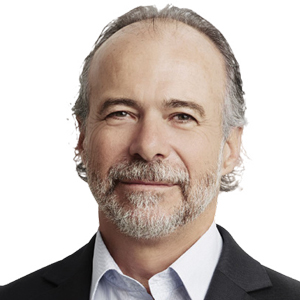THANK YOU FOR SUBSCRIBING

Prerequisites to Embrace and Master Digital Transformation
Richard Suhr, Global Digital Lead, Advisory and Partner, ERNST & Young


Richard Suhr, Global Digital Lead, Advisory and Partner, ERNST & Young
Having worked as the MD of Google’s Enterprise Geospatial Division in Asia Pacific, Suhr, now, is responsible for leading the integration of digital strategy across all service lines, industries, and regions to accelerate growth and strengthen EY's position as a leader in digital consulting. He is also the co-founder of a technology investment company, and advises multiple technology start-ups. In this interview with APAC CIO Outlook, Suhr shares his views on Digital Transformation and what innovation, optimization, and disruption really means.
Q. Could you take us through the major technological and behavioral trends you see shaping the enterprise market?
A. Technological and behavioral trends shaping the enterprise market are certainly happening hand in hand. Enterprises must keep pace without knowing the future, compete against companies that don’t yet exist, and balance what’s working today with what needs to change for tomorrow.
The sharing economy, for example, is undoubtedly changing how we live and work and has sparked new business models empowered by multiple disruptive technologies. These technologies tap into cloud-based, collaborative apps on high-bandwidth, always-on mobile networks, and the Internet. Through these apps, anyone can access information to instantaneously match their demands— thus creating disruptive economic efficiencies.
At EY, we’re also thinking about the impact that the sharing economy has on our staff, and how we adapt and build the world’s best employee experience aligned with our “Future Work Now” strategy.
Considering how we can integrate companies like Airbnb or WeWork into our own business process has forced us to look at all elements of the business– compliance, tax, human capital strategy, employee lifecycle management, and more. In some ways, the technology changes are the easy part. The really interesting part is the potential that these new services bring to make us a dramatically better employer.
From a technology perspective, waves of new technology in cloud, AI, analytics, IoT, machine learning, and automation will keep accelerating, so the key for our clients is to try to focus on how new entrants and competitors are using that to either disrupt the current business model, or launch new models.
Q. What are some of the future aspects that you are excited about? How will the digitization strategy look like a few years down the line?
A. These days, when you look at each traditional service and solution in isolation, they are becoming less relevant, or more commoditized. It’s rare today for an enterprise to have a straightforward problem with a straightforward solution.
So what enterprises need now– and for the foreseeable future– are:
It’s Rare Today For An Enterprise To Have A Straightforward Problem With A Straightforward Solution
• A strategy for growth and innovation. Enterprises have to decide where to play and how to win, with programs for constant innovation and a business model designed to adapt to a changing marketplace that may mean growing beyond borders, and considering global growth.
• Purpose-led transformation. EY has a service offering that helps organizations with strategic transformation that leads with purpose, which serves as a motivating and centering foundation to drive strategic transformation.
• A digital enterprise strategy. Enterprises need to make the most of their social media, mobile technologies, and advanced analytics, cloud computing, and other emerging technologies.
• A plan for profitability. Having a clear purpose can set the strategic vision with a burning ambition, followed by agile innovation with pilots to pull organizations onto the new strategic growth trajectory.
• A strategy for smart capital allocation. Choosing the right strategic investments–whether organic or inorganic–offers paths to growth. Now more than ever, there’s a need to balance decisions about buying, partnering, building, and venturing.
Finally, we think there is a material new opportunity being created for large enterprise clients who can embrace the trend around sector convergence. The constant acceleration of ubiquitous, cloud-based, cheaper technology is making it technically easier for larger organizations to converge.
Q. What are the key takeaways from your vast experience that you would highlight, and how do you share those with your team?
A. The three most significant opportunities and challenges for enterprises are:
• Build a network or influence and insight to understand how the world is changing. This means enterprises must get diverse and connect people onto boards and executive teams with different experiences.
• Shift to a more formal and structured portfolio investment approach. Enterprises should help their board understand the return on these differential investments. Often those truly disruptive investments do not have known return models, so discussions about investments and shareholder return must be transparent.
• Challenge the organization to be clear about what capability you want to build, in particular, what capability you want to “rent” and what capability you might need to buy. In a constantly-changing landscape, organizations need a thoughtful, structured “buy versus build’ strategy to ensure that innovative ideas are not abandoned or missed.
Q. Are any other interesting insights you would like to share with us?
A. Recently, I met a team that is launching a new virtual reality/augmented reality accelerator. They are working across technology companies, start-ups, the film sector and universities to create commercially-driven VR research projects, which are supported by the government.
Two things struck me as really incredible about the team and what they are doing. First, I asked them to help me understand what was unique about the application. We talked about the example of VR being used to help offer better palliative care outcomes by simulating recovery environments for cancer patients, coupled with R&D that combines behavioral science, clinical trials, emerging film and media technology, and sensory experience. It struck me that most of our large-scale enterprise clients do not necessarily have the bandwidth or networks to bring all of these types of science and technology skills together in one place.
Second, almost all of the individual companies that I met in the accelerator are very early-stage and pre-money, and all are working on remarkably different R&D problems. I realized that there is no way that traditional, large enterprises can build that level of diversity and breadth in their R&D and product design process on their own.
I get excited thinking about how enterprises can begin to connect to this new world, how they can embrace the world of disruption and convergence to build new models, and how much innovation we are going to see in the next five to 10 years.
The growth potential is almost unlimited if enterprises can find the right governance, investment models and culture to re-learn how they collaborate in these new digital models.












